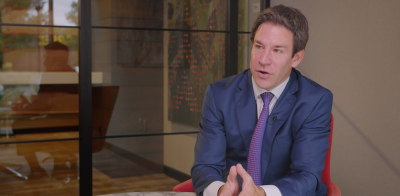As we enter April after a strong bear market rally in Q1, the old adage “Sell in May and Go Away” springs to mind as the most logical path forward, particularly for those who have yet to adjust their asset allocation to the new reality of the Galactic Mean Reversion. But what are you waiting for? A VIP invite to protect capital? Is there really meaningful upside left after a mini-banking crisis drove a dramatic repricing of expectations for both future Fed rate hikes in the near term followed by more aggressive cuts in the medium term and lower interest rates from the 3-month Treasury Bill to the 30-year Treasury Bond? Are lower interest rates driven by a more rapid expected decline in inflation driven in turn by an increased risk of recession sooner rather than later good for economically sensitive assets?
- With the S&P 500 now trading at around 18.4X 2023 earnings, at this point equity markets are valued at only 2.8 multiple turns (or 13%) cheaper than they were coming into 2022 when the Galactic Mean Reversion/current bear market officially began—does that sound like a bargain to you? Remember, during the entire 2002 to 2007 bull market, equity multiples never exceeded 15X. Prior to QE3 (quantitative easing)1, the S&P 500 never reached a valuation above 14X coming out of the Global Financial Crisis.
- The permabull crowd would have you believe a 13% discount from the highest equity valuations since the dot-com bubble is a bargain because at some point, inflation will revert to 2% and mega cap tech is back as the trade du jour again. However, if you compare the current market/economic dynamics to the end of 2021, it should be pretty clear a 13% discount just isn’t enough:
- The Fed has hiked by 4.75% in record time and is not done yet.
- The 10-year Treasury yield is 2% higher than the end of 2021, even after the recent 75 bps decline from last year’s peak.
- Money supply had been contracting at an unprecedented pace until the Fed had to again expand its balance sheet to save the weakest links in the U.S. banking system.
- Real estate is now experiencing a sustained downturn.
- We’ve had the second and third-largest bank failures in U.S. history.
- Already tightening credit conditions will certainly tighten even further.
- The FDIC had to commit around one-sixth of their insurance fund just to find a buyer for Silicon Valley Bank.
- The risk of a debt ceiling debacle is uncomfortably high.
- Recession risk has increased from an already historically high probability and the time horizon pulled forward, which will erase any expected increase in earnings and drive at least a modest drop.
- The S&P 500 already hit its multiple/valuation trough at 15.75X last October, which is a rather bullish assumption, but we think fair given these facts/assumptions:
- The Fed just undid almost 70% of their balance sheet contraction and 50% of money supply contraction to bail out poorly run banks.
- After a 42% surge, money supply has only shrunk by around 2%, so we still have around 40% more money supply than pre-pandemic.
- The Fed only hikes 1 to 2 more times in 25 bps increments but then cuts slowly and gingerly starting end of 2023/early 2024.
- 10-year Treasury yield has peaked.
- A mild recession causes earnings to contract by 10% from the recent peak.
- Multiples compress back to 16X to 17X at the market bottom forward earnings estimates bottom.
- If these assumptions are correct, this gets us to a potential 3200 to 3400 low in the S&P 500 (a lower low), which make a lot of sense to me for the following reasons:
- Meaningfully/measurably worse bear market/correction than 2018 or eurozone crisis: 29% to 34% peak to trough decline vs. around 20%.
- Meaningfully/measurably less disastrous than the dot-com bubble and global financial crisis bear markets of greater than 50% peak to trough declines.
- Since the Fed announced the pace and magnitude of quantitative tightening2, I’ve always thought a 30% to 40% peak to a trough bear market made a lot of sense, and don’t see any rational reason to change that now.
- This implies around 17% to 22% more downside from current S&P 500 levels, which will be no fun indeed if you are still overweight beta. Unless of course, you’ve embraced democratized alternatives!
- Clearly, the ultimate outcome could be slightly better (the Fed, Treasury and FDIC ring fence banking system, consumer keeps economy going, service inflation subsides faster, etc.) or worse (just think stagnation—economy has harder landing, service inflation stays more entrenched, the Fed doesn’t cut until unemployment is at 6%, etc.).
- The S&P 500 already hit its multiple/valuation trough at 15.75X last October, which is a rather bullish assumption, but we think fair given these facts/assumptions:
So back to the “Sell in May and Go Away…but what are you waiting for”—if you have maybe 3% to 5% more upside in the current rally and potentially around 20% downside from here, then you know what you have to do! Fight inertia, trim your equity exposure and embrace democratized alts because “The Time for the RIGHT Alts is still Now.”
Investing in alternatives is different than investing in traditional investments such as stocks and bonds. Alternatives tend to be illiquid and highly specialized. In the context of alternative investments, higher returns may be accompanied by increased risk and, like any investment, the possibility of an investment loss. Investments made in alternatives may be less liquid and harder to value than investments made in large, publicly traded corporations. When building a portfolio that includes alternative investments, financial professionals and their investors should first consider an individual’s financial objectives. Investment constraints such as risk tolerance, liquidity needs and investment time horizon should be determined.



